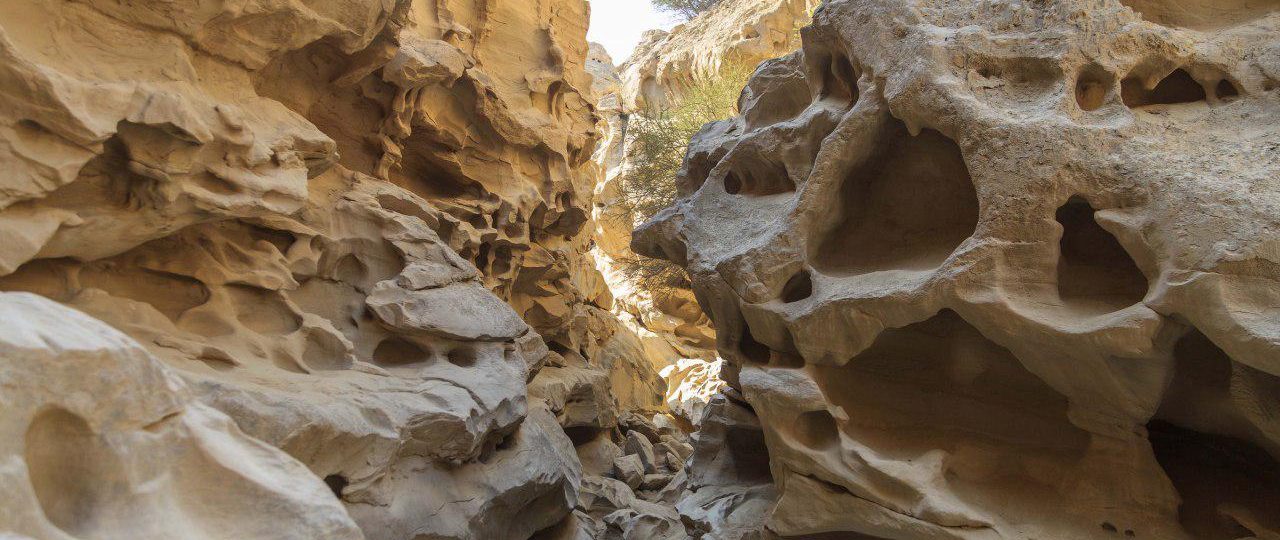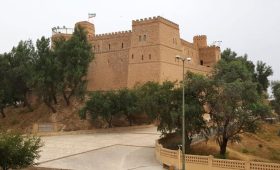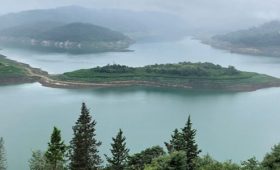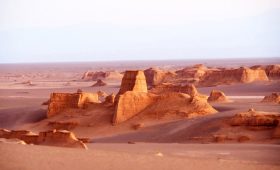The beautiful island of Qeshm is one of the important touristic parts of Iran, which annually hosts a large number of tourists from different parts of Iran and the world. This island is considered to be the first geopark in the Middle East and the trip to it brings people to the most extraordinary sights. Chah kooh Gorge is a natural and unique attraction that is considered one of the sights of Qeshm and is formed in the heart of the island.
The beautiful island of Qeshm, with an area of 1500 square kilometers, is considered the largest island in the Persian Gulf and is located in the Strait of Hormuz. The direction of this island is from northeast to southwest. Qeshm includes unique and surprising attractions in its heart, and there are seven main attractions in it, which are known as the Seven Wonders of Qeshm.
The Seven Wonders of Qeshm are among the sights of Hormozgan and are located within the Qeshm Geopark. Geopark refers to an area where there are several significant and unique geological, natural, cultural and biological phenomena. Qeshm Geopark is the first and only geopark in the Middle East that was registered in UNESCO’s global network of geoparks in 2006. After Malaysia, China, Korea, Vietnam and Japan, Iran is known as the sixth Asian country that has a geopark.
Chah Kooh Gorge is one of the wonders of Qeshm and is one of the main sites of Qeshm Geopark. This gorge is located in the western part of the northern coast of Qeshm Island and in the central part of the Geopark. Chah Kooh Gorge is a natural and extraordinary attraction in an area called Shahab, that is located 70 kilometers from Qeshm and near the village of Chahavi East.
Chah Kooh Valley is so beautiful and unique that you feel like entering another planet by stepping into it. Chah Kooh Gorge is nature’s art. The atmosphere of the valley looks different and strange, and the handwriting of nature is different in this part of the earth. In the gorge, rocks with a depth of 100 meters grow tall with a strange appearance and will unwittingly captivate you with their greatness.
The amazing and angular shapes of the stones in the Chah Kooh Gorge amaze everyone with the power of nature. The rocks in the valley are so smooth and polished as if we are on the side of clouds and sponges. Visitors to the valley wonder how time has overcome the hard nature of the rock by leveraging water and wind.
Natural processes have worked hand in hand and over millions of years, they have patiently created this unique work of art. This gorge has rocks that have been amazingly eroded over time and have taken on a look that can only be seen in a limited number of places in the world. The limestone rocks of this region have acquired their current appearance over millions of years by strong winds and flowing water.
At the entrance of the Chah Kooh Gorge, there is a natural statue known as the “Three Guardian Heads”. After the statue, there are four wells that are a place to store fresh water for the residents around the gorge. Chah Kooh strait has been the most important source of fresh water supply for the island and its surrounding residents for hundreds of years. This area is sacred to the natives of the area and is known as the holy valley. The reason for this belief goes back to the distant past; when the natives of the region used the water collected in its wells and holes; they used to heal their patients.
The name of the Chah Kooh gorge is composed of the combination of two parts “well” and “mountain”, which goes back to the use of the gorge, especially in the past. The wells and natural holes formed in the heart of the wall and the bottom of the gorge were one of the reasons for this name. Another and perhaps the main reason for this name is the presence of four wells at the starting point of the gorge, which were dug by the residents of the villages near the Chah Kooh gorge, and they provide the possibility of storing fresh water and rainfall throughout the year. These wells are used as a source of fresh water storage for the summer, and the running water and rain remain in them.
On the way to Chah Kooh Gorge, there is a narrow atmospheric channel that leads the water into the wells. These canals and wells are 400 years old. Most of the time, a guard is present at the wells of the Chah Kooh gorge and he kindly draws water from the well for those who ask for water.
The main reason for the formation of Chah kooh gorge and its similar valleys is the fracture created in a large taqdis. Taqdis are vault-like folds of the earth that have also had an impact on the creation of other attractions in Qeshm, such as the salt dome and Namakdan cave. The natural forces of the earth have caused a fault to cross-cut a single stone mountain and create four gorges. Chah kooh Gorge and what is seen in it is the result of long years of erosion by wind, rain water, torrential rains and sunlight.
Chah Kooh Strait is connected to the Zagros Mountains. This gorge actually includes the main valley and the valley perpendicular to it and forms a shape like a crossroads. Chah Kooh has four gorges on its four sides, whose walls are connected to each other, and you can enter the gorge from all of them. When we enter the gorge from one side, after navigating a relatively short path, we encounter two gaps on both sides, each of which leads us to a new path with new features.
The path of Chah Kooh Gorge narrows from north to south and its slope increases. The change in the width of the gorge and its slope indicate that the valley is flooded. At the end of the valley, it narrows. In this part of the gorge, the distance between the two walls reaches half a meter; While the walls are still very high. These conditions make the atmosphere of the gorge look very dark; But the sky clearly shows through the layers of the walls.
The acid in the rainwater has eroded the limestone wall of the Chah kooh gorge
The sedimentary walls of Chahkooh Gorge are composed of loose calcareous sandstones and middle layers of red marl, silt and lime. The presence of these materials in the structure of the gorge has made the road susceptible to erosion and dissolution. The grooves and parallel erosion lines in the walls are very deep and take the shape of a spoon or a funnel. In the bottom of Chah Kooh Gorge, there are natural shallow holes where rainwater is stored for a while.
Lime or calcium bicarbonate in the wall of the gorge reacts to the acid in the rainwater and dissolves in it. This process creates small cracks and holes. Water cannot penetrate these stones; for this reason, this erosion occurs layer by layer and the water flows out or evaporates after circulating in the holes. Repeating this process over time causes the holes to grow bigger day by day and over millions of years deep and long grooves and all kinds of lenticular, spoon and spherical holes are formed in the wall and floor of the valley.
Vegetation in the Chah kooh area is trees and shrubs that are compatible with the desert and tropical climate of the area. Although the Chah Kooh gorge is water route; but except for a small amount of grass and limited desert thistle, there is no special vegetation inside the gorge. The natural wells in the area have caused species of animals and birds to live there.
The high walls of Chah kooh Gorge are full of natural holes. This place seems to be a great and ideal option for rock climbing; Of course, doing this sport requires professional equipment and sufficient skill.




